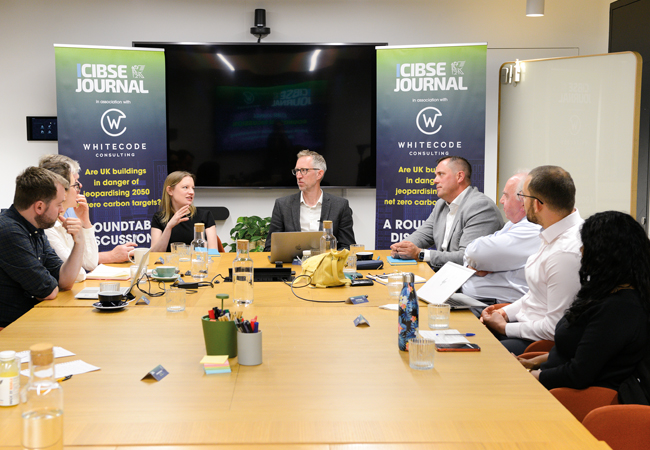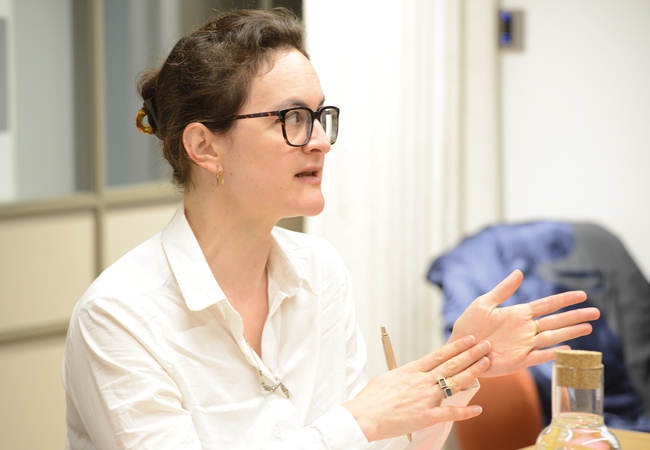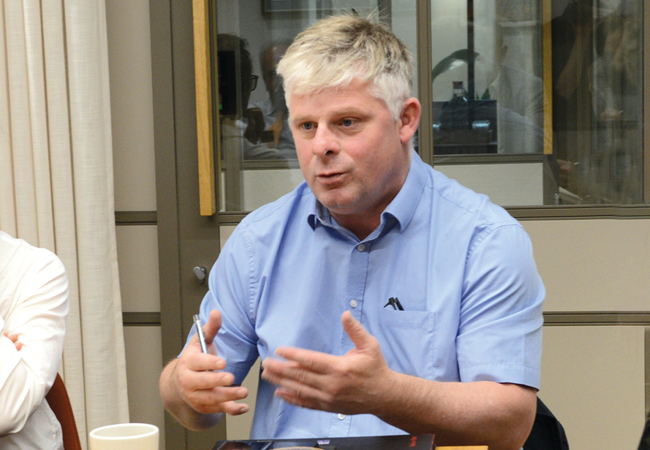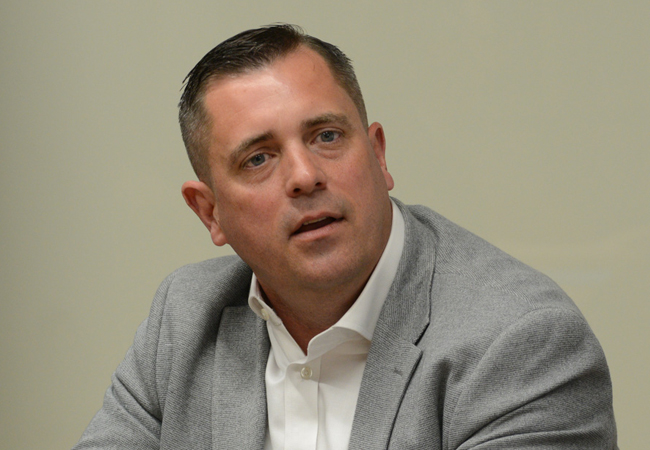
A single silver bullet won’t deliver net zero by 2050; several factors will be required. That was the conclusion of experts at CIBSE Journal’s latest roundtable, sponsored by Whitecode Consulting. Political courage, an urgent timeline and policy implementation were some of their key recommendations to help the industry achieve this vital target.
The panel
Bean Beanland – director for growth and external affairs, Heat Pump Federation
Julie Godefroy – head of net zero policy, CIBSE
Stephen Hart – director of integrated solutions, Baxi Heating
Alex Hill – managing director, Whitecode Consulting
Ellen Huelin – sustainability director, Whitecode Consulting
Daniel Logue – adviser, decarbonising sites, Energy Systems Catapult
Tom Lowe – founding director, Thermal Storage UK
Yogini Patel – head of campaigns, Passivhaus Trust
Alex Smith – editor, CIBSE Journal
The topic of the event was whether UK buildings are in danger of missing net zero carbon targets without a definitive roadmap for their decarbonisation. Yogini Patel, head of campaigns at the Passivhaus Trust, stressed the importance of speed. ‘Everything needs to happen now, and quickly,’ she said. ‘We need to decarbonise energy supplies, lower our demand, and skill up the construction sector. For that to happen effectively, we need a plan – leadership from the top and bottom, with a long-term commitment. All we have now is complete uncertainty.’
Julie Godefroy, head of net zero policy at CIBSE, agreed. ‘The energy system is decarbonising, but there isn’t enough happening with heat pump support,’ she said. ‘Retrofit is one area where there is nothing. The Climate Change Committee has flagged this up, but the government [Conservative] has hidden behind some vague plan.’

Yogini Patel
We need to decarbonise energy supplies, lower our demand, and skill up a construction sector that’s ready to deliver – Yogini Patel
Another issue is the lack of adequate electrical infrastructure, which is threatening to derail the drive for decarbonisation, according to Daniel Logue, adviser for decarbonising sites at Energy Systems Catapult. Alex Hill, managing director at Whitecode Consulting, said it was affecting his projects, and he cited a scheme in west London where Whitecode Consulting installed heat pumps. ‘We have been told we can have a megawatt a year and we want nine megawatts – they said we could have power in nine years. We have a big power problem,’ said Hill. ‘We need to deal with the transition for distribution so we can share the power we are making, such as the wind power generated further up the country.’
Tom Lowe, founding director of Thermal Storage UK and a retrofit assessor, is optimistic that the Grid will withstand future growth. ‘We are now building it to be flexible; we have power generation coming in from the north and, along the east coast, we have massive grid build,’ he said. ‘To decarbonise homes, we need to put in an electric heating system, install heat pumps – which could be done for about 70% of homes over the next 10 years, assuming the Grid is built at the same time. The technology is there, we just need the workforce.’

Ellen Huelin
SAP was never designed to do full energy calculations; it’s a compliance tool. It’s a barrier to reaching net zero – Ellen Huelin
Lowe added that the industry must learn lessons from historical transformations of heating systems if it is to achieve carbon zero by 2050. He warned that energy companies should not rely on people installing solar panels and heat pumps to decarbonise, as these devices are only for those who can afford it or who can get subsidies. Many people who don’t fall into either of these categories will get left behind, he said. People will then vote for political parties that think net zero should disappear rather than be resolved. ‘We need to commit to a 10 to 15-year plan now to coordinate this,’ Lowe added.
Ellen Huelin, sustainability director at Whitecode Consulting, said the UK should focus on making buildings more energy efficient. The problem with new build, she added, is that it’s policy-led, and developers only comply with a policy if its mandatory: ‘We’re moving towards the Future Homes Standard [FHS] and, unless it’s contained within the policy for new build, clients will be reticent to go for upgrades.’ Patel agreed that retrofit is a huge area to be unlocked, and stressed that a building’s fabric must be considered and energy loads reduced. However, while fabric improvements should be considered, Lowe believes a fabric-first approach is not required for all homes to decarbonise.’

Julie Godefroy
A building passport would contain things that already exist, but that are currently disparate, paper-based and unusable – Julie Godefroy
The discussion then moved to the value of heat pumps. Bean Beanland, director for growth and external affairs at the Heat Pump Federation, stressed the importance of providing incentives to encourage people to adopt heat pumps, particularly commercial building owners. Hill agreed, but said he was worried domestic customers would pay more for their systems than they thought.
‘Customers don’t know that the running costs of heat pumps will, potentially, be 25% more because electricity is too expensive,’ said Hill. ‘My worry is that people will remove them, as they are too costly, and revert to gas. This will give heat pumps a bad name, because we haven’t sorted our electricity generation. We must decouple gas from electricity.’
Most of the panel agreed that the high cost of heat pumps was a deterrent – but in commercial situations, Hill added, space and complexity are barriers, too: ‘What’s interesting, as a designer, is that there’s no one solution; every site where we apply this technology is slightly different, so we go for hybrid [gas and heat pump].’

Daniel Logue
Electricity generation isn’t the problem, it’s the lack of infrastructure – Daniel Logue
Stephen Hart, director of integrated solutions at Baxi Heating, sympathised. ‘We must invest in our engineering staff to offer something that’s more manageable for the designer,’ he said. ‘We know the future will be hydrogen, heat networks, heat pumps, or a combination. Hybrid is the way to go because sustainability shouldn’t be the enemy of affordability or security.’
Lowe was asked about his experience with manufacturers of heat batteries in the domestic and industrial sectors. He said products are now being made that use phase-change materials – which alter the state of a substance and provide latent heat without changing the temperature – as the main storage capacity of the unit, instead of hot water. Huelin hoped that changes to the FHS and the new Home Energy Model (HEM) for calculating energy use would offer more opportunities to use these innovative technologies, as she believes the current Standard Assessment Procedure (SAP) is very restrictive.

Bean Beanland
It’s important to provide incentives to encourage people to adopt heat pumps, particularly for commercial building owners – Bean Beanland
‘SAP was never designed to do full energy calculations; it’s a compliance tool and is very rigid in what we can put into it,’ said Huelin. ‘It’s a barrier for getting to net zero.’
Godefroy added that the Product Characteristics Database, which holds data for the technologies that can be used in a SAP, was in need of an update. There is a plan to allow innovative products to be tested and mobilised faster, she said, and it was agreed that making this process quicker would encourage more people to select new products.
The panel then discussed how to deliver better-quality buildings, with Patel stressing the importance of quality assurance processes. ‘You need to make sure you’re testing things after they are built to close that performance gap,’ she said. The performance levels being designed to should be met in operation, and ‘funding should be linked to that. It’s about having measurable targets.’

Tom Lowe
Fabric improvements are needed, but fabric-first is not required for all homes to decarbonise – Tom Lowe
Incentivising people was also important, said Patel, so they feel involved and want to do a good job. She cited policy legislation for Scottish schools that would introduce a Passivhaus-style system to ensure buildings were tested against energy targets. ‘When you connect funding with measured performance and outcomes, you incentivise a whole team,’ she said.
Godefroy highlighted a proposal in the FHS consultation that would reward developers that measure performance in buildings. It’s not yet clear whether this is for performance that goes beyond the Building Regulations, she added, but it was an acknowledgement of the importance of measuring.
Hill said making data visible is vital. ‘We need a sharing of data… so we can use it and improve,’ said Hill. ‘The problem now is that lots of people who collect data use it for their own ends.’

Stephen Hart
We’re finally picking up momentum with the Heat Networks Assurance Scheme, which will force developers to register their building and understand performance levels – Stephen Hart
Hart believes momentum is building around the Heat Networks Technical Assurance Scheme, which is due in 2025 and aims to ensure that heat networks meet a minimum level of performance and reliability. ‘It will force developers to register their buildings connected to heat networks and understand what the performance levels are,’ Hart said. ‘It’s driving people to investigate buildings and work out what they’ve got.’
Beanland would like to see public money spent on building assessments, with the resulting information contained in building passports. This could then be passed to the next owner to enable them to see a building’s history. Godefroy added that the HEM could form the basis of a building passport, and confirmed that the idea is becoming more than a concept, and would contain information such as works carried out and a building’s Energy Performance Certificate (EPC) rating. ‘It [the passport] would contain things that already exist, but that are currently disparate, paper-based and unusable,’ she said.
Beanland said people should also be aware of the Centre for Net Zero’s ‘Smart Building Rating’, which is designed to complement a reformed EPC and the distribution network operator’s (DNO’s) ‘Connection Readiness Certificate’. Subject to funding, a DNO will run a pilot on the rating and certificate next year and, if successful, it will be made widely available. ‘It will mean that the DNOs have proactively inspected parts of their network,’ said Beanland. ‘This emerged from the DNOs trying to identify where the heat pump hotspots will come from, so they can plan for reinforcement.’

What’s interesting, as a designer, is that there’s no one solution; every site where we apply this technology is slightly different – Alex Hill
Logue was interested in these emerging tools as he is working on a project for Northern Powergrid that is predicting energy demand for non-domestic sites. The idea is to use data to forecast when the energy transition will happen in different areas of the country.
Summary
Achieving net zero by 2050 requires a multifaceted approach, concluded the panellists, who emphasised the need for political courage, urgent policy implementation, and a clear timeline. Key recommendations included rapid decarbonisation of energy supplies, reducing energy demand, and investment in skills.
They also concluded that support for heat pumps and retrofitting remains insufficient, and that inadequate electrical infrastructure poses a significant challenge. The need for quality assurance, incentivisation and measurable targets was highlighted, and emerging tools – such as building passports and smart building ratings – were seen as promising steps towards a coordinated energy transition.
Ultimately, innovative technologies, strategic planning, and strong leadership are crucial if the UK is to meet its net zero carbon targets.
